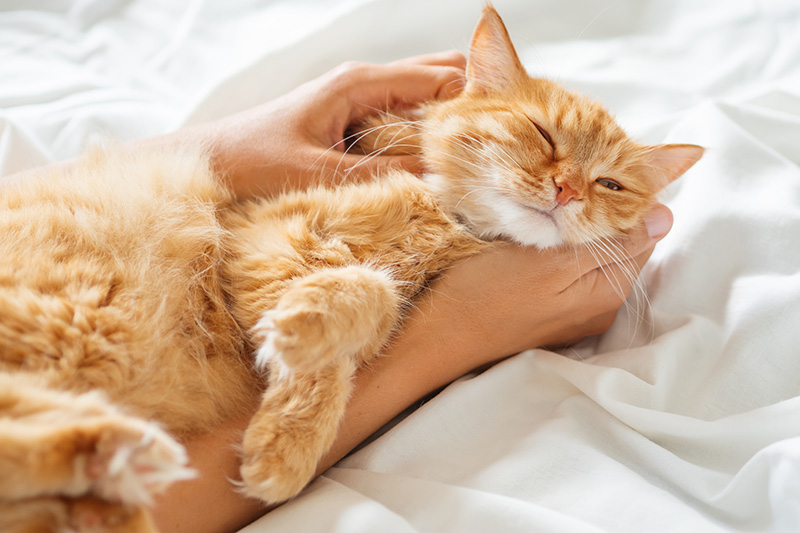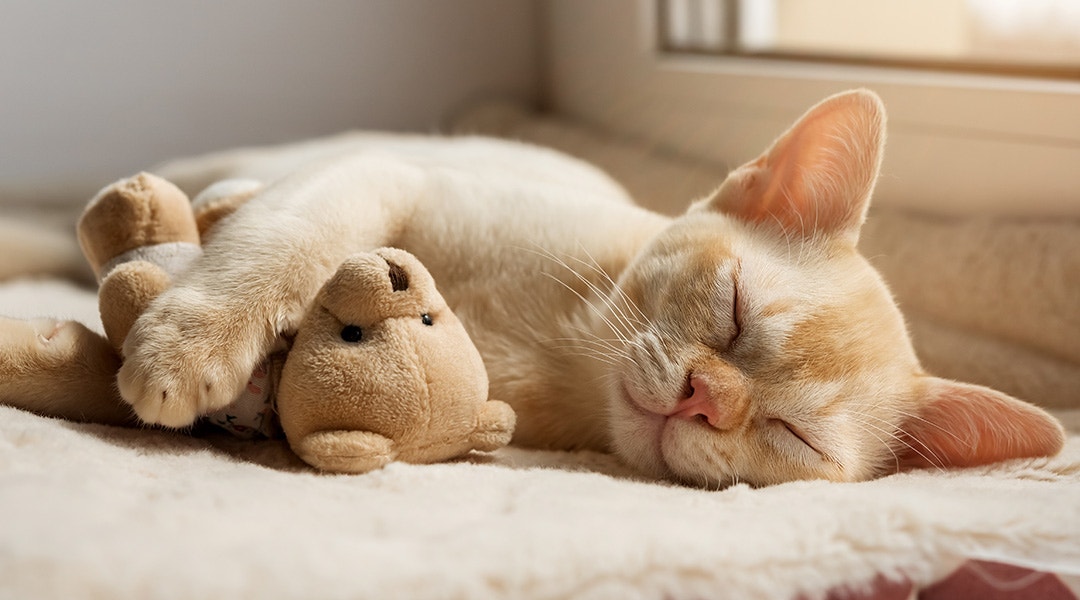Cats are amazingly vocal animals, with a huge repertoire of sounds they use to communicate their wants, needs and concerns. Cats use different cat sounds to communicate with their pet parents as well as with other cats and other animals.
In this article on cat noises, we’ll look at the different noises cats make and what they mean. Understanding what different cat sounds mean will help you understand your cat better, so you can form a closer bond.
Why Do Cats Make Noises?
Cats use vocal communication with people to express their needs and their emotions.
Cats express their wants and needs through a wide variety of meows and other cat noises. Cats have a wide vocabulary that covers everything from saying hello or asking for something to telling you they want to be left alone. Cat sounds also express emotions, with sounds expressing everything from delight or excitement to distress and fear.
Did you know that adult cats use meowing almost exclusively with humans? That’s right. After kittenhood, cats save meowing for use on you and their other favourite people.
Cats also have sounds they use to communicate with other cats and other animals. Cats might even have noises for lulling prey into a sense of security when they’re hunting.
Common Cat Noises and Their Meanings
Here are the most common cat noises and an explanation of what they mean.
1. Meow
Meow is the number one cat noise!
Cats know exactly how to tell us what they want with meows. Every cat will use a whole range of meows to communicate different needs, wants and emotions.
There are four main types of meow:
- Standard short meows – Every cat will have its own standard short meow it uses when it’s making a basic, simple request. This will be a familiar sound. It could mean your cat is looking for you, wants attention or wants something like food. Listen carefully, and you’ll notice that your cat also has different types of short meow.
- Longer meows – Cats tend to use a longer meow when they are feeling impatient. Often, it means there is something in particular on their mind. It might mean you’ve forgotten about dinnertime, for example, or your cat is feeling bored. The lower pitched this type of meow is, the more serious the demand.
- Mewls – Mewls are short and sweet sounds kittens use to natter away at their mothers. Cats often use mewls to say hello to their pet parents. Check if your cat mewls at you next time you walk in the door.
- Repeated short meows – If a cat quickly repeats short meows, this means it’s excited about something.
Sometimes, a cat will start meowing more than normal. This can be a sign there’s something wrong, although there are many possible explanations.
2. Purring
Purring is a nice, relaxing sound for us humans to hear. This is a low pitched, rumbling noise that cats make automatically as they breathe. Normally, it means your cat is feeling very happy and relaxed.
There are times, however, when cat purring indicates that a cat is in pain or distress. Cats also use purring as a form of self soothing when they are sick, injured or psychologically distressed. If purring happens unexpectedly or there are other worrying signs of trouble, it could indicate that your cat is in trouble.
3. Trilling
Trilling is a delightful cat noise. This is when a cat makes a high pitched, louder purr like noise to show you that it is happy with you. Often, cats will show you their appreciation with a quick trill after you feed them or give them some attention.
People often hear trilling as a mrrp sound.
4. Chirping and Chirruping
Chirping and chirruping are also delightful cat noises.
The chirp cat noise is a short, high pitched sound that sounds like a very over-excited meow. It sounds very different to other cat noises and is often described as a bird like noise. Chirruping is when a cat chirps many times in quick succession.
Cats chirp and chirrup when they’re excited. Often, they’ll do it when they’re sitting in the window watching birds or other prey in the garden. Some people believe that cats may chirrup as a hunting tactic to lull wild animals into a false sense of security.
When you first hear your cat chirp, you might wonder why your cat is making weird noises. Chirping and chirruping can sound strange when you first hear it.
5. Chattering and Twittering
Chattering (also called twittering) is similar to chirruping, but it’s lower pitched and is produced mainly with jaw movements. Chattering is an unusual noise, and you might wonder why your cat is making weird noises when you first hear it.
6. Growling
Cats growl when they feel threatened, and the sound is designed to scare off potential threats. This is a low pitched rumbling sound that gets louder the more threatened the cat feels. If a cat growls, this means it is feeling aggressive, and it could scratch or bite. Sometimes cats alternate growling with hissing or even spitting.
Always give a cat space if it is growling at you!
7. Hissing and Spitting
Cat hissing is another defensive sound that sometimes comes with spitting.
When a cat hisses, it will open its mouth wide to show you its teeth and rapidly exhale to make a low pitched hissing noise like a snake. Cats will make this noise if they feel threatened, if they’re angry or when they’re fighting each other.
Spitting is a shorter and more explosive version of a hiss.
8. Yowling
Cat yowling is a noise cats make when they are in distress. This sound can indicate that a cat is in pain. Otherwise, it might mean it is psychologically distressed. Cats also yowl and howl when they fight each other. In a fight, growls will often turn into yowls and then into howls.
Yowling is another weird-sounding noise that cats make.
9. Caterwauling
Female cats caterwaul when they are in heat to attract mates. Caterwauling is a high pitched wailing cat noise that resembles a yowl but sounds less alarming or distressed. It is a long, loud whining sound.
If you have a female cat that is making weird noises and also being overly affectionate, being more active and spending time outdoors, this is a sign it’s in heat.
What Can Your Cat’s Noises Tell You?
Cat noises can tell you a lot about your cat. Cats make the noises mentioned above to indicate different wants, needs and concerns. As well as this, however, they also make all the different types of noise in unique ways, depending on circumstances. Cats will often make noises at a higher pitch, more frequently or more loudly if they are excited, for example.
Different cats also communicate in different ways. The best thing is to observe your cat closely to see how it naturally communicates. You should also consider the context when your cat communicates with you.
If you’ve just bought a kitten, why not try to learn all its different sounds as it develops?

When to Worry About Cat Noises
You can pay attention to your cat’s noises in case they indicate that your cat is in need of something. The best approach is to try and understand all the different noises your cat makes, so you know when and when not to act.
Some things that could indicate that your cat is in pain or distress are:
- Unexpected yowling or howling
- Unexpected growling, hissing, and spitting
Besides this, it’s a good idea to pay attention if your cat suddenly changes its vocalisation habits or if noises it makes are accompanied by other signs of trouble.
You don’t normally need to worry if your cat is making noises that just sound weird. Chirping, chirruping, chattering, yowling, and caterwauling are all unusual noises that cats make naturally at certain times.
Strengthening Communication With Your Cat
Understanding your cat’s different noises and what they mean will help you form a closer bond with it.
Once you know what your cat means when it talks, you’ll be able to respond to different sounds with the right action. Whether your cat’s having a grumble, asking for attention or needs help with something, you’ll know what to do.
Don’t forget that DREAMIES™ treats are your best chance of getting a trill (a thank you) out of your cat.
FAQ - Cat Noises
What sounds does a cat make?
Cats make a wide variety of sounds. They are intelligent and vocal animals with a wide range of sounds for different purposes. Meowing is the most common sound, although cats also make other noises like purring, trilling and chirruping, or growling, hissing and spitting.
Why do cats answer to pspspsps?
Cats are naturally intrigued by the sound pspspsps because it mimics sounds in nature and triggers their curiosity. Cats also learn to respond to sounds like pspspsps if they’re owners reward them for doing so.
What does it mean when a cat says Mrrp?
When a cat says mrrp, it means thank you. The official word for a mrrp noise from a cat is a trill, and it is a noise cats make when they are appreciative of something. If you give your cat a treat or stroke it, it might say mrrp as a thank you. No one is sure how to say ‘you’re welcome’ in cat, but you can try different sounds.
What is the noise coming from my cat?
Cats make a lot of different noises. Refer to the information in this guide to understand what different noises cats make. If your cat is making weird noises, it could be chirping, chirruping, chattering, yowling or caterwauling.





